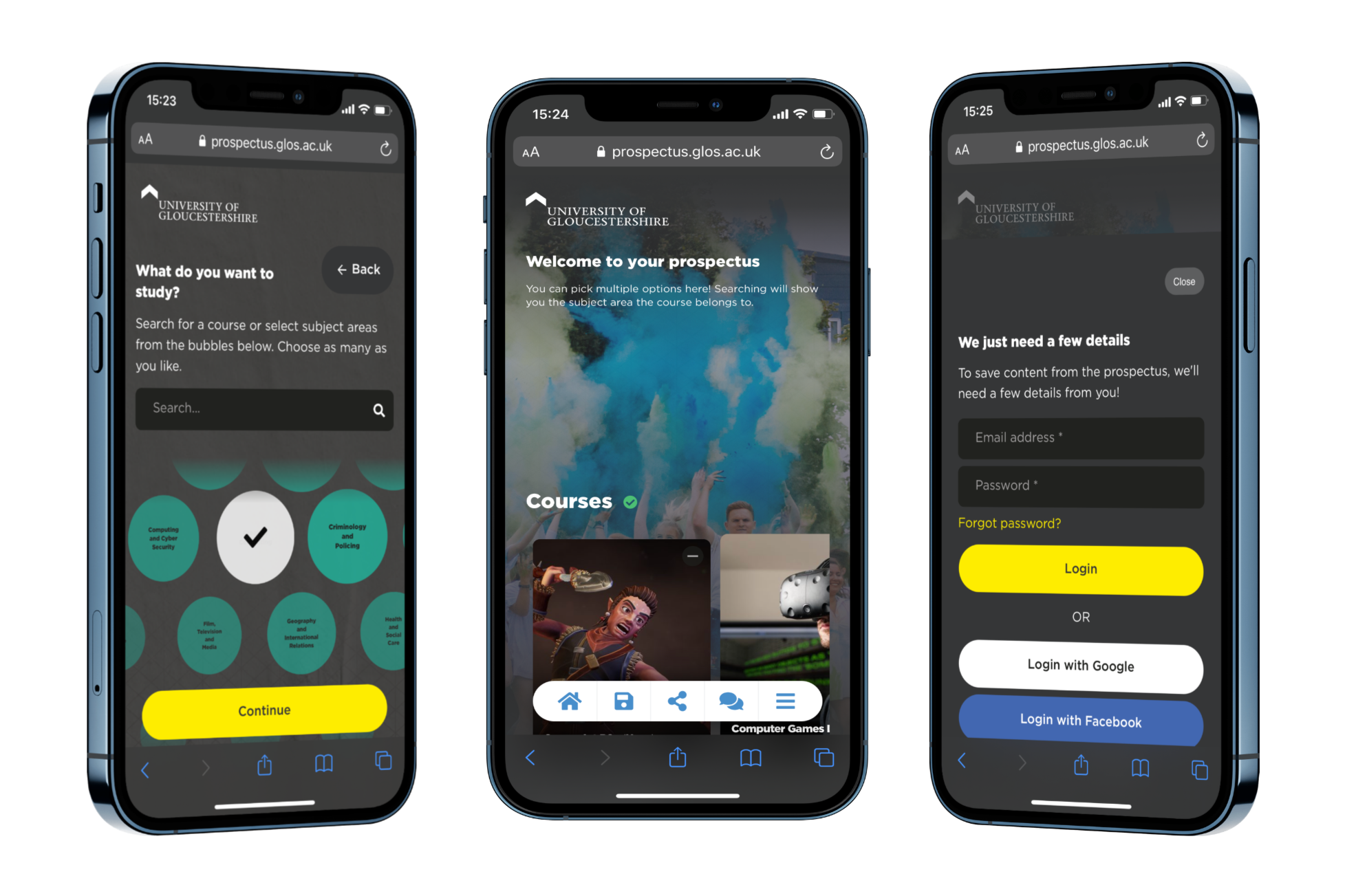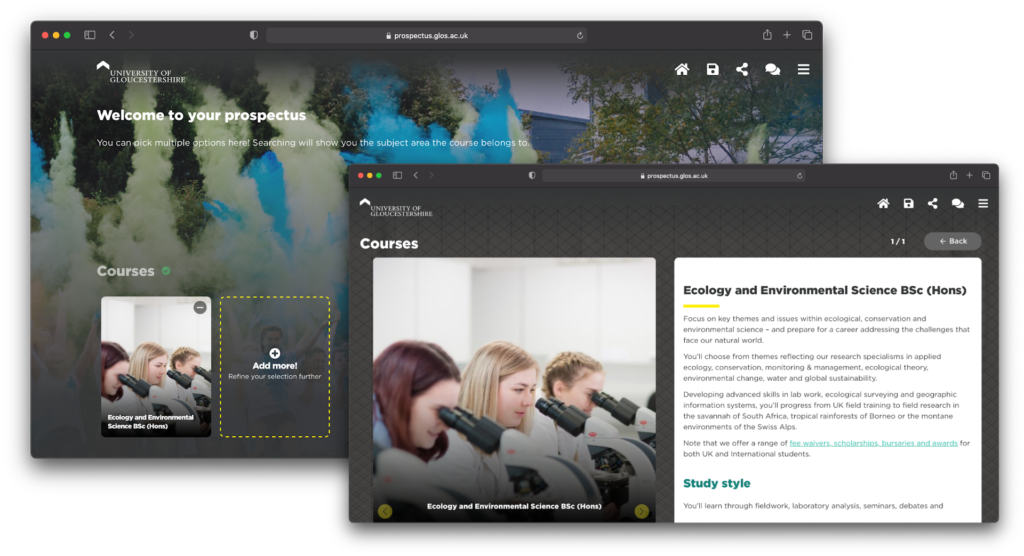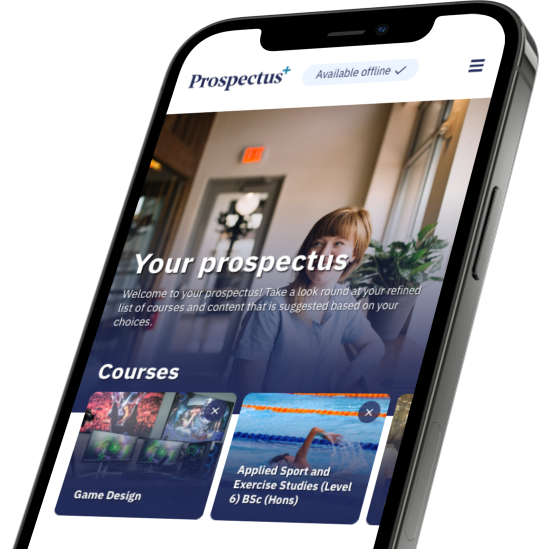University of Gloucestershire’s Transition to a Digital Prospectus
As the term suggests, a “digital prospectus” is an evolution of the traditional printed prospectus, but merely sticking the word “digital” in front doesn’t do it justice. The reality is that this shift is not just about going paperless—it’s a fundamental transformation in how universities communicate with their prospects.
When the COVID-19 pandemic struck in 2020, distributing physical prospectuses became an increasingly impractical and unsustainable process. Many institutions found themselves stuck with mountains of unused prospectuses, making the need for an alternative glaringly obvious. That’s when the University of Gloucestershire recognised the opportunity for change. Rather than just digitising the status quo, they saw the potential for a digital prospectus to be a personalised, trackable, and eco-friendly solution that resonated with today’s tech-savvy, environmentally conscious students.

The Challenge:
Modernising the University Prospectus
Traditional prospectuses were often bulky, costly, and largely irrelevant to the individual prospect’s needs. With only a small fraction of the content being of interest to any one reader, it was time to rethink the format. Moreover, the next generation of students—Gen Z and Millennials—are more eco-conscious than ever before, with 70% of them actively changing their purchasing decisions due to concerns about climate change. The University of Gloucestershire, already a leader in sustainability, knew they needed to align their recruitment strategy with the values of their target audience.
A shift was already underway: less than 10% of students surveyed in 2021 requested a physical copy of a prospectus, with most opting for online alternatives. The pandemic accelerated this trend, cementing the fact that print materials were no longer a priority for prospective students. Yet, traditional university websites were often bloated and impersonal, failing to engage users effectively or guide them towards key decision-making information. The university needed something that bridged the gap between a static website and a printed brochure—a tool that offered personalisation, interactivity, and real-time data capture.
The Solution:
A Personalised Digital Experience
In partnership with Prospectus Plus, the University of Gloucestershire launched their 2022 digital prospectus—not just as a “digital” version, but as a fully personalised and interactive experience. The prospectus allowed prospective students to customise the content based on their interests, selecting specific courses, accommodation options, and facilities that mattered to them. This customisation created a unique user journey, offering a bespoke prospectus that could be saved, referenced, and edited later.
More than just a content repository, the digital prospectus integrated seamlessly with the university’s new flagship website via an API. This connection ensured real-time updates and reduced the editorial overhead for the marketing team—freeing up hundreds of hours that would have been spent manually updating printed materials. Instead of having to rely on outdated print workflows, the university could focus on more strategic, impactful communications.

Success Metrics:
The Impact of the University of Gloucestershire’s Digital Prospectus
The University of Gloucestershire’s transition to a digital prospectus has been nothing short of transformative. By leveraging technology, sustainability, and personalisation, the university has achieved remarkable success, as evidenced by the following key metrics:
317% Increase in Year-on-Year (YoY) Prospectus Users
Since adopting the digital prospectus, the university has seen a 317% surge in users, a testament to the broader reach and accessibility of the platform. The removal of barriers, such as the data capture form, has played a significant role in this growth by allowing prospects to explore the content without friction. This shift not only increased engagement but also expanded the university’s pool of potential applicants.
45% Increase in Mobile Users
With the increasing preference for mobile devices, Prospectus Plus is designed to be fully optimised for mobile usage. As a result, there has been a 45% rise in mobile users, showcasing the importance of making higher education content accessible on the go. This mobile-first approach aligns perfectly with the habits of prospective students, who favour quick, easy access to information through their phones.
Over Half of Users Personalise Their Prospectus
One of the standout features of the digital prospectus is the ability for users to personalise it according to their preferences. More than 50% of users take advantage of this option, creating a bespoke experience that speaks directly to their interests. This level of personalisation not only increases engagement but also positions the university as responsive to individual needs, making it more attractive to prospects.
An Increase in International Consumption
The digital prospectus has also extended the university’s global reach. During a five-month period (March to August 2021), nearly 15% of users were international, illustrating the power of the digital format in breaking down geographical barriers. By making the prospectus accessible worldwide, the university has been able to attract attention from a more diverse, international audience.
76% Saving in Production Costs Over 5 Years
The move to a digital-first prospectus has not only benefited the environment but also delivered substantial financial savings. Over a five-year period, the university has seen a 76% reduction in production costs, freeing up valuable resources and time that can now be invested in other key projects. This saving goes beyond just money—it represents a strategic shift towards more efficient and sustainable recruitment processes.
10% Increase in Applications
The proof of success lies in the numbers: the university has experienced a 10% increase in applications compared to 2020, when a physical prospectus was still in use. This growth demonstrates that the personalised, digital experience resonates with prospective students and has a direct impact on their decision-making process.

A student summed up the benefits of the digital prospectus perfectly:
“It is much better as physical ones are heavy and it takes a while to find specific courses and not every piece of information is written on or it is too small to read. An online one is so much easier and flows. I really like the fact it is tailored to your interests.”
Student, University of Gloucestershire Survey
This feedback encapsulates why the digital prospectus is a game-changer—not just for the university but for the students it aims to attract. By providing a tailored, easy-to-navigate, and eco-friendly alternative, the University of Gloucestershire has positioned itself as a leader in higher education recruitment for the digital age.
Join the Prospectus Plus revolution
Jump on a video call, and discuss the future of your prospectus.

